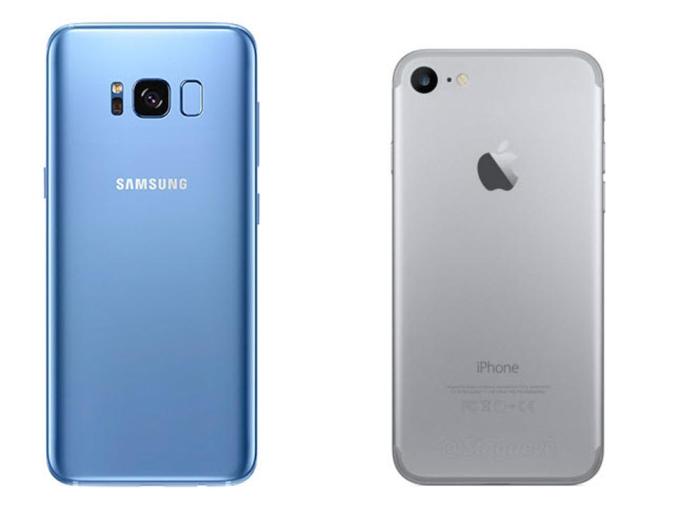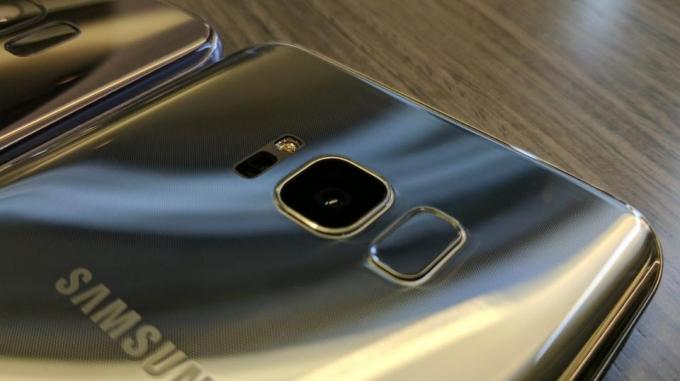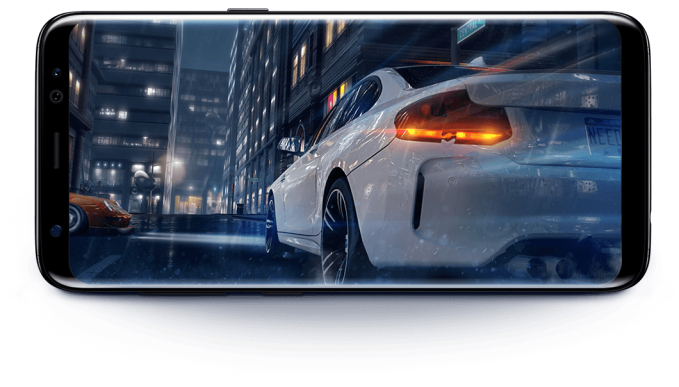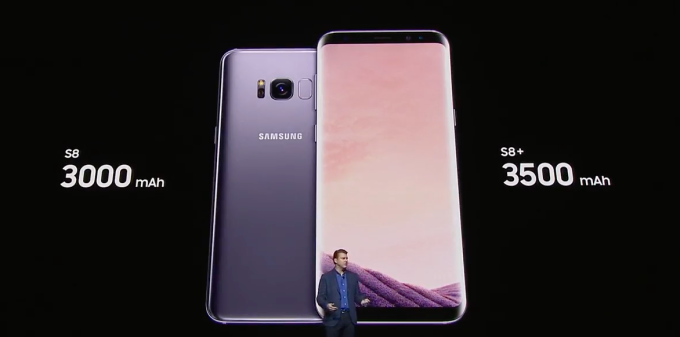Apple will radically redesign the iPhone later this year, but for the bulk of 2017 the biggest smartphone rivalry will be between the iPhone 7 and Samsung’s new Galaxy S8. But what are the key differences between them and which makes for the better upgrade? It’s not as simple as you might think. (This article is posted at Forbes by Gordon Kelly )
iPhone 7 Review: a water-resistant body, better cameras, 256GB capacity and no headphone jack
Step to play iTunes Movies or TV Shows on Galaxy S8 and S8 Plus
Step to play iTunes Movies or TV Shows on Galaxy S8 and S8 Plus
Displays - Samsung’s Stunning Win
Look closely at the iPhone 7 and Galaxy S8 and you’ll find they are competitively matched in many areas, but displays is not one of them:
- Galaxy S8 - 5.8-inch Super AMOLED, 1440 x 2960 pixels (570 ppi pixel density), 83.6% screen-to-body ratio, Corning Gorilla Glass 5
- iPhone 7 - 4.7-inch LED-backlit IPS LCD, 1334 x 750 pixels (326 ppi), 65.6% screen-to-body ratio
- Samsung Galaxy S8 vs iPhone 7
It is worth pointing out the Galaxy S8 ‘only’ defaults to 2220 x 1080 pixels by default to save battery life (a key concern, more later) but that’s still miles ahead of the iPhone 7 and another reason Apple is finally expected to produce an OLED iPhone later this year. It’s simply a better technology.
iPhone 7 wins? The only potential plus point here is the iPhone’s flat display. The Galaxy S8 has a dual curved display which Samsung smugly called the ‘Infinity Display’ and not everyone likes curved panels because they can register a lot of accidental touches.
Design - Smartphone Future Vs Smartphone Past
And here is the Galaxy S8’s second big win and it is where the screen-to-body ratio shines because, despite how huge Samsung’s screen is, the smartphone is not much bigger or heavier:
- Galaxy S8 - 148.9 x 68.1 x 8.0 mm ( 5.86 x 2.68 x 0.31-inch), 155g (5.36 oz)
- iPhone 7 - 138.3 x 67.1 x 7.1 mm (5.44 x 2.64 x 0.28 in) and 138 g (4.87 oz)

This aside, however, the iPhone 7 does have some design advantages. It’s aluminium back is more durable than the Galaxy S8’s glass (though the latter is there to offer wireless charging) and you can easily unlock with your fingerprint face down on the table. This long running functionality has gone from the Galaxy S8 as its screen is too big to fit the sensor and Samsung’s solution is ridiculous.
The Galaxy S8 fits the fingerprint sensor on the back (which is fine), but positions it high up beside the camera so you smudge the lens every time you unlock the phone (uncool). Samsung even has added software props to warn users about this.
The Galaxy S8 strikes back though as it has both iris (fast and secure) and facial (fast and insecure) recognition. You’ll have to point the phone at your face for this to work, which is a little conspicuous, but it’s undeniably cool and something Apple is expected to copy sooner rather than later.

Elsewhere the Galaxy S8 also has the benefit of a microSD slot supporting up to 256GB of storage expansion, a 3.5mm headphone jack and it has higher IP68 water and dust resistance compared to IP67 certification on the iPhone 7 (both allow full submersion for up to 30 minutes in water, but IP68 is in up to 1.5 metres while IP67 is in one metre).
Cameras - Samsung Leads But Stagnates
Two years ago Samsung snatched the smartphone camera crown from Apple and you will get marginally better photos from the Galaxy S8 than the iPhone 7. But the reason for this is disappointing: the Galaxy S8 uses the same main camera hardware as the Galaxy S7 which edged out Apple’s phone.
Samsung does make software improvements (new multi-shot processing combines several images to create each shot), but early tests suggest it won’t surpass current smartphone camera champion the Google Pixel XL (sample below) and it opens the door for Apple to also surpass it with the iPhone 8 later this year.
- Galaxy S8 vs Google Pixel XL
Where the match is closer, is the front facing camera. The Galaxy S8 has an 8MP module with a fast f/1.7 aperture compared to the iPhone 7’s 5MP module with slower f/2.2 aperture. But this isn’t the big win Samsung has been enjoying since the Galaxy S6.
Performance - Samsung Continues To Self Sabotage
If you have noticed coverage of the Galaxy S8, you’ll have heard about its party trick: it can turn into a barebones desktop computer if you purchase the optional $150 Samsung DeX dock. This connects to a monitor via HDMI and keyboard and mouse from USB. In this mode it runs a hacked version of Android with a desktop UI and support for Android apps, Citrix Receiver and Amazon Workspaces.

It’s clever and could be a hit with businesses looking to save costs, but for consumers this is unlikely to remain their main PC. Furthermore when you look purely at mobile software, Samsung continues to use TouchWiz to take everything great we saw about stock Android on the Google Pixel and tear it away or needlessly duplicate it (Bixby < Google Assistant / Siri; Connect < Google Home/Apple Home).
Then there’s the two app stores, two calculators, two web browsers, two mobile payment services, two clocks, etc. It’s pointless. Meanwhile the Galaxy S8 won’t even ship with an up to date version of Android. Android 7.0 comes out the box, while Android 7.1 is nearly six months old. This is why the stereotypes around Samsung software exist: because they are true.
- Galaxy S8 (US) - Qualcomm Snapdragon 835 octa-core chipset (4x 2.35GHz and 4x 1.9GHz Kryo CPUs), Adreno 540 GPU; 4GB of RAM
- Galaxy S8 (Europe and Asia) - Exynos 8895 (4x 2.3 GHz & 4x 1.7 GHz CPUs), ARM Mali-G71 MP20 GPU; 4GB of RAM
- iPhone 7 - Apple A10 Fusion chipset: Quad Core CPU, Six Core GPU, 2GB of RAM
Yes, I still found the Galaxy S8 retains the customary stutters and drops frames of animation navigation the UI and, no matter how close benchmarks claim the Snapdragon 835 (US) and Exynos 8895 (International) versions are, it simply doesn’t come close to matching the smooth responsiveness of iOS on the iPhone 7.
You will get connectivity benefits on the Galaxy S8 such as Bluetooth 5.0 (2x speed, 4x range of Bluetooth 4.2) and LTE (4G) speeds up to one gigabit, but these are standards for the future rather than something you’ll be able to take advantage of right now.
Battery Life - Questions All Round
Last year Samsung did an exceptional job with the Galaxy S7 highlighting how stagnant Apple has been with its three generations of 4.7-inch iPhone. But this year it is Samsung which looks set to have taken a step back.
On paper Samsung should have the win (3000 mAh vs 1960 mAh), but iOS has always gotten away with smaller capacity batteries. Meanwhile the Galaxy S8 retains the same capacity as the Galaxy S7 despite its successor increasing display size (the biggest battery draw) by a massive 0.7-inches. It’s going to be a miracle if the Galaxy S8 remains anywhere close to the Galaxy S7’s staying power.
That said I still expect it to edge past the iPhone 7 (the iPhone Plus models have always been the battery life kings), but Samsung has missed an opportunity here to cement its lead.

Then again when it comes to charging, the Galaxy S8 batters the iPhone 7. Its quick charge technology can deliver up to 50% charge in 15 minutes and a full charge in an hour. Even using an iPad charger, an iPhone 7 cannot get near this. Then there’s the Galaxy S8’s wireless charging which is still faster than an iPhone 7 with its standard wired charger.
Apple has been asleep at the wheel for several years here and it needs to change. Happily it just might…
But will the Galaxy S8 explode? It shouldn’t. Samsung has a new ‘8 Point Quality Check’ which is class leading and improved cycle longevity means it will lose just 5% capacity after one year. Rivals typically drop 15-20%. There’s also USB Type-C charging, which Apple really should adopt if it is going to continue fittings its MacBooks with Type-C but no Lighting port.
Price And Storage - Increases All Round
If you’re still struggling to decide between these two phones, then their difference in price is not going to help you:
- Galaxy S8 - 64GB - $750 / €799 / £689
- iPhone 7 - 32GB ($649), 128GB ($749) and 256GB ($849)
The Galaxy S8 is $100 more expensive than the launch price of the Galaxy S7 which makes the 128GB iPhone 7 look a potentially better deal. But don’t forget the Galaxy S8’s expandable storage. You’ll also get a premium pair of AKG headphones bundled (worth $99) which are far superior to Apple’s awful wired earphones.
The Galaxy S8 is a stunningly beautiful smartphone that is leagues ahead of the iPhone 7, but Samsung's software remains a let down and means the iPhone 7 is still the smoother, faster handset to use Gordon Kelly
The Galaxy S8 is a stunningly beautiful smartphone that is leagues ahead of the iPhone 7, but Samsung's software remains a let down and means the iPhone 7 is still the smoother, faster handset to use.
The Galaxy S8 is a stunningly beautiful smartphone that is leagues ahead of the iPhone 7, but Samsung's software remains a let down and means the iPhone 7 is still the smoother, faster handset to use.

没有评论:
发表评论